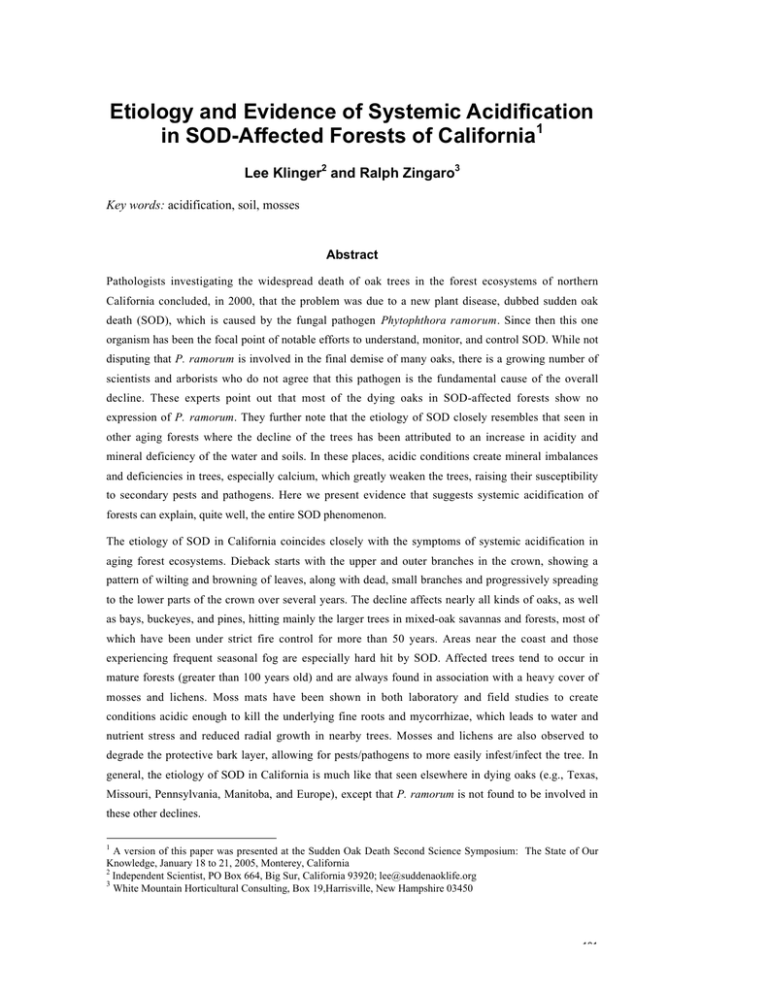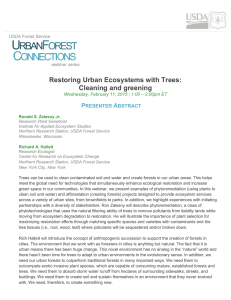Etiology and Evidence of Systemic Acidification in SOD-Affected Forests of California
advertisement

Etiology and Evidence of Systemic Acidification in SOD-Affected Forests of California1 Lee Klinger2 and Ralph Zingaro3 Key words: acidification, soil, mosses Abstract Pathologists investigating the widespread death of oak trees in the forest ecosystems of northern California concluded, in 2000, that the problem was due to a new plant disease, dubbed sudden oak death (SOD), which is caused by the fungal pathogen Phytophthora ramorum. Since then this one organism has been the focal point of notable efforts to understand, monitor, and control SOD. While not disputing that P. ramorum is involved in the final demise of many oaks, there is a growing number of scientists and arborists who do not agree that this pathogen is the fundamental cause of the overall decline. These experts point out that most of the dying oaks in SOD-affected forests show no expression of P. ramorum. They further note that the etiology of SOD closely resembles that seen in other aging forests where the decline of the trees has been attributed to an increase in acidity and mineral deficiency of the water and soils. In these places, acidic conditions create mineral imbalances and deficiencies in trees, especially calcium, which greatly weaken the trees, raising their susceptibility to secondary pests and pathogens. Here we present evidence that suggests systemic acidification of forests can explain, quite well, the entire SOD phenomenon. The etiology of SOD in California coincides closely with the symptoms of systemic acidification in aging forest ecosystems. Dieback starts with the upper and outer branches in the crown, showing a pattern of wilting and browning of leaves, along with dead, small branches and progressively spreading to the lower parts of the crown over several years. The decline affects nearly all kinds of oaks, as well as bays, buckeyes, and pines, hitting mainly the larger trees in mixed-oak savannas and forests, most of which have been under strict fire control for more than 50 years. Areas near the coast and those experiencing frequent seasonal fog are especially hard hit by SOD. Affected trees tend to occur in mature forests (greater than 100 years old) and are always found in association with a heavy cover of mosses and lichens. Moss mats have been shown in both laboratory and field studies to create conditions acidic enough to kill the underlying fine roots and mycorrhizae, which leads to water and nutrient stress and reduced radial growth in nearby trees. Mosses and lichens are also observed to degrade the protective bark layer, allowing for pests/pathogens to more easily infest/infect the tree. In general, the etiology of SOD in California is much like that seen elsewhere in dying oaks (e.g., Texas, Missouri, Pennsylvania, Manitoba, and Europe), except that P. ramorum is not found to be involved in these other declines. 1 A version of this paper was presented at the Sudden Oak Death Second Science Symposium: The State of Our Knowledge, January 18 to 21, 2005, Monterey, California 2 Independent Scientist, PO Box 664, Big Sur, California 93920; lee@suddenaoklife.org 3 White Mountain Horticultural Consulting, Box 19,Harrisville, New Hampshire 03450 181 GENERAL TECHNICAL REPORT PSW-GTR-196 Data on pH from 34,700 soil samples taken from a wide range of agricultural and forest soils in California indicate that between 14 and 21 percent of the soils are acidic (pH < 6.0) and 3 to 4 percent are strongly acidic (pH < 5.0). However, a subset of samples taken from SOD-affected sites indicates that 72 percent of these soils are acidic and 4 percent are strongly acidic (median pH = 5.7; n = 132). The soils from these sites were also found to be consistently low in calcium and very high in soluble aluminum and iron. Spatial analysis reveals a strong coastal gradient in soil pH with the lowest pH values found near the coast. Strong coastal gradients are also apparent in soil calcium, which is lowest near the coast, and in soil aluminum, which is highest near the coast. Precipitation chemistry data from this region also reveal a coastal pH gradient much like that found in the soils. Similar coastal gradients in precipitation pH have been reported from the Olympic Peninsula, from southeast Alaska, and from Scandinavia. These results lend further support to the hypothesis that systemic acidification is adversely affecting the health of the trees and soils in SOD-affected forests. The situation described here in California is not unlike that in other regions of the world where aging forests are experiencing decline. From this and other work (e.g., studies at Hubbard Brook), we strongly believe that the cause (and the definition) of SOD is still an open question, and that the scope of SOD research should be expanded to include studies of acidification by cryptogams in the context of forest and soil ecology. 182







